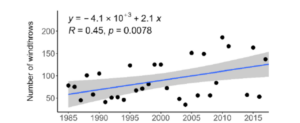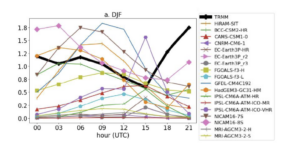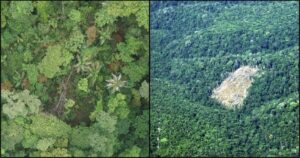Wind-driven tree mortality in the Amazon has increased fourfold since 1985

Figure: Increase of windthrow events ≥ 30 ha in the Amazon
The Science
Windthrows, the uprooting or breaking of trees by winds, in the Amazon are produced by downdrafts associated with strong convective storms. They are a major natural disturbance that can influence the structure, carbon balance and species composition of forests. Our results document an approximately four-fold increase in large (≥30 ha) windthrows during the analyze period (1985 to 2020). Overall, we detected no changes in the size distribution or severity of windthrows over the past 35 years., except for an increase in very large events (>500 ha) since 1990. Thus, it is the number of events that has increased.
The Impact
Given predictions of increased storm severity with global warming, the number of windthrows are also predicted to increase. This is likely to make wind disturbance an important mode of tree mortality, especially if large trees become more vulnerable to snapping and uprooting as a consequence of other emerging disturbances
Summary
Convective storms with strong downdrafts create windthrows—areas of snapped and uprooted trees—that locally alter forest structure, composition, and carbon balance. Using Landsat imagery from consecutive years, we documented the temporal and spatial variation of large windthrows (≥30 hectares) across the Amazon basin between 1985 and 2020. Over the 33-year period, we identified 3,179 large windthrows. Windthrow density was highest in central and western Amazon regions, with ~33% of all events occurring within ~3% of the monitored area. In these “hotspot” regions, return intervals for large windthrows at the same location span centuries to millennia, while in the rest of the Amazon, return intervals exceed 10,000 years. Our data show a nearly fourfold increase in the number of windthrows and affected area, from 78 events (6,900 ha) in 1985 to 264 events (32,170 ha) in 2020, with an increase in events larger than 500 hectares after 1990. These extremely large windthrows (ranging from >500 ha to 2,543 ha) drive interannual variation in median (84 ± 5.2 ha; ±95% CI) and mean (147 ± 13 ha) windthrow area. However, we found no significant temporal trends in the size distribution of windthrows over time.
Contact
Robinson Negron-Juarez
Lawrence Berkeley National Laboratory
robionson.inj@lbl.gov
Funding
J.D.U.M. has been supported by the Max Planck Institute of Biogeochemistry, the German Academic Exchange Service (DAAD). D.M.M. and S.T. are supported by the ATTO Project funded by the German Federal Ministry of Education and Research (BMBF, contracts 01LB1001A and 01LK1602A), the Brazilian Ministério da Ciência, Tecnologia e Inovação(MCTI/FINEP contract 01.11.01248.00) and the Max Planck Society. S.T. and J.D.U.M also acknowledge support from the Balzan Foundation. R.N.J. is supported by the Next Generation Ecosystem Experiments-Tropics, and the Office of Science’s Regional and Global Model Analysis of the US Department of Energy, Agreement Grant DE-AC02-05CH11231, and Reducing Uncertainties in Biogeochemical Interactions through Synthesis Computation Scientific Focus Area (RUBISCO SFA). M.V.P has been supported by Forest Data Connect of the National University of the Peruvian Amazon
Publication
Urquiza-Muñoz J, Trumbore S, Negron-Juarez R, Feng Y, Brenning A, Vasquez-Parana M, Marra D. Increased occurrence of large-scale windthrow across the Amazon basin, AGU Advances, 2024. DOI: http://dx.doi.org/10.1029/2023AV001030




